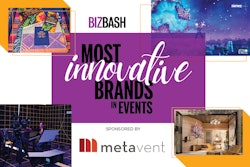
The Basics: Global media giant Condé Nast, which is owned by Advance Publications, boasts a roster of top-name print and digital publications, including Vogue, The New Yorker, GQ, Glamour, Architectural Digest, Vanity Fair, Pitchfork, Wired, and Bon Appetit. But, as is the case with many media enterprises, the company has also immersed itself deeper and deeper into the world of events. And the epic challenges of 2020 didn’t stop the progress. Condé Nast produced over 350 events globally last year, pivoting to virtual seamlessly. For example, The New Yorker Festival—traditionally hosted at physical venues across New York City—was reimagined as a virtual experience with socially distant in-person activations for locals.
 The New Yorker Festival, which is traditionally hosted at physical venues across New York City, was reimagined as a virtual experience with socially distant in-person activations for locals.Photo: Courtesy of Condé Nast
The New Yorker Festival, which is traditionally hosted at physical venues across New York City, was reimagined as a virtual experience with socially distant in-person activations for locals.Photo: Courtesy of Condé Nast
 Virtual visitors could recreate the spaces with shoppable designer-approved products.Photo: The Boundary
Virtual visitors could recreate the spaces with shoppable designer-approved products.Photo: The Boundary
Lessons Learned: “Something that’s stood out is the importance of pushing boundaries, of being creative, and of taking risks,” Johnson says about Condé Nast's transition to virtual events. “There are thousands of virtual events taking place at any given moment, and many consumers are already spending their entire day on Zoom. A simple ‘in-conversation’ format isn’t enough anymore. It’s about providing a completely unique experience that consumers can’t get anywhere else—online or in person.” He pointed back to the Iconic Home event as an example, saying that it was a “unique, participatory event that reimagines the ways we’ve typically engaged with Architectural Digest’s audience, and will influence how we do so in the future.”
What’s Next: “It’s clear that virtual is here to stay, and we’re committed to creating the most dynamic virtual opportunities in the marketplace. We’re also thinking about how we can apply some of what we’ve created virtually to our in-person events when they return, extending both their reach and their lifespan by making them available to digital audiences before, during, and after the physical event. As we build a platform for 2021, we’ll be looking for ways to incorporate a consistent virtual component,” Johnson says.
 Eric Johnson, SVP of commercial marketing and events for Condé Nast, pointed back to the Iconic Home event as an example, saying that it was a “unique, participatory event that reimagines the ways we’ve typically engaged with Architectural Digest’s audience, and will influence how we do so in the future.”Photo: The Boundary
Eric Johnson, SVP of commercial marketing and events for Condé Nast, pointed back to the Iconic Home event as an example, saying that it was a “unique, participatory event that reimagines the ways we’ve typically engaged with Architectural Digest’s audience, and will influence how we do so in the future.”Photo: The Boundary



















